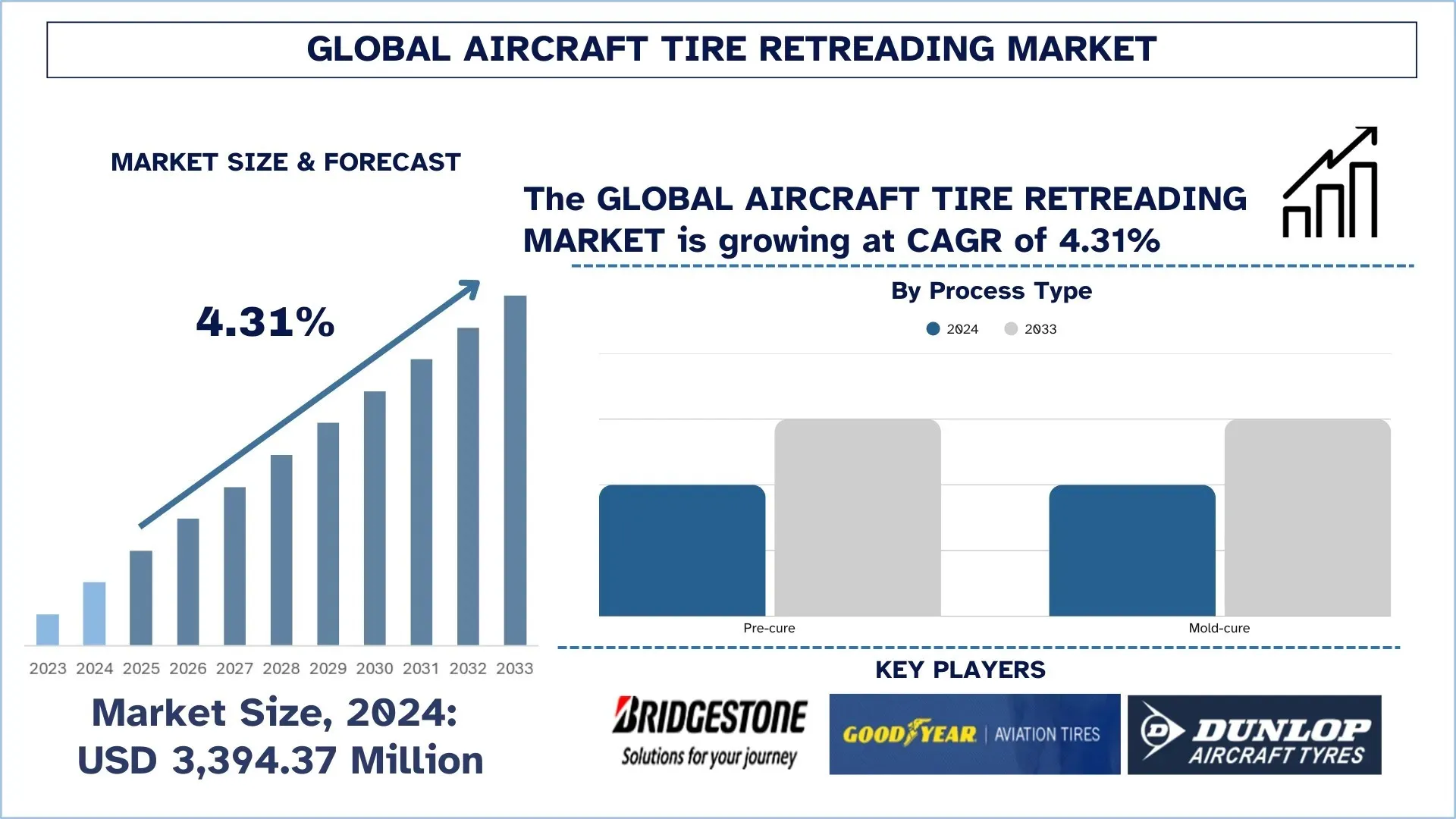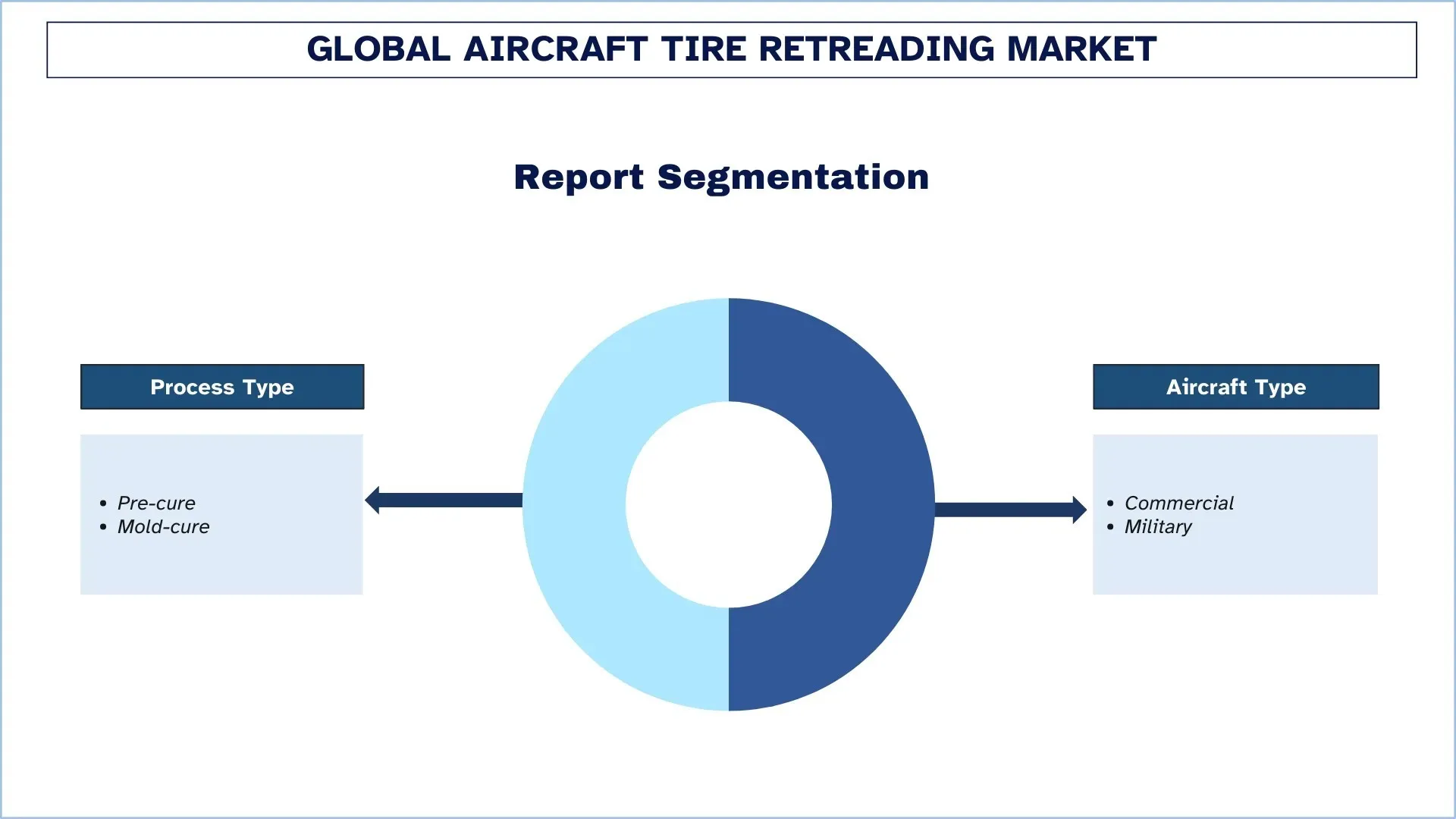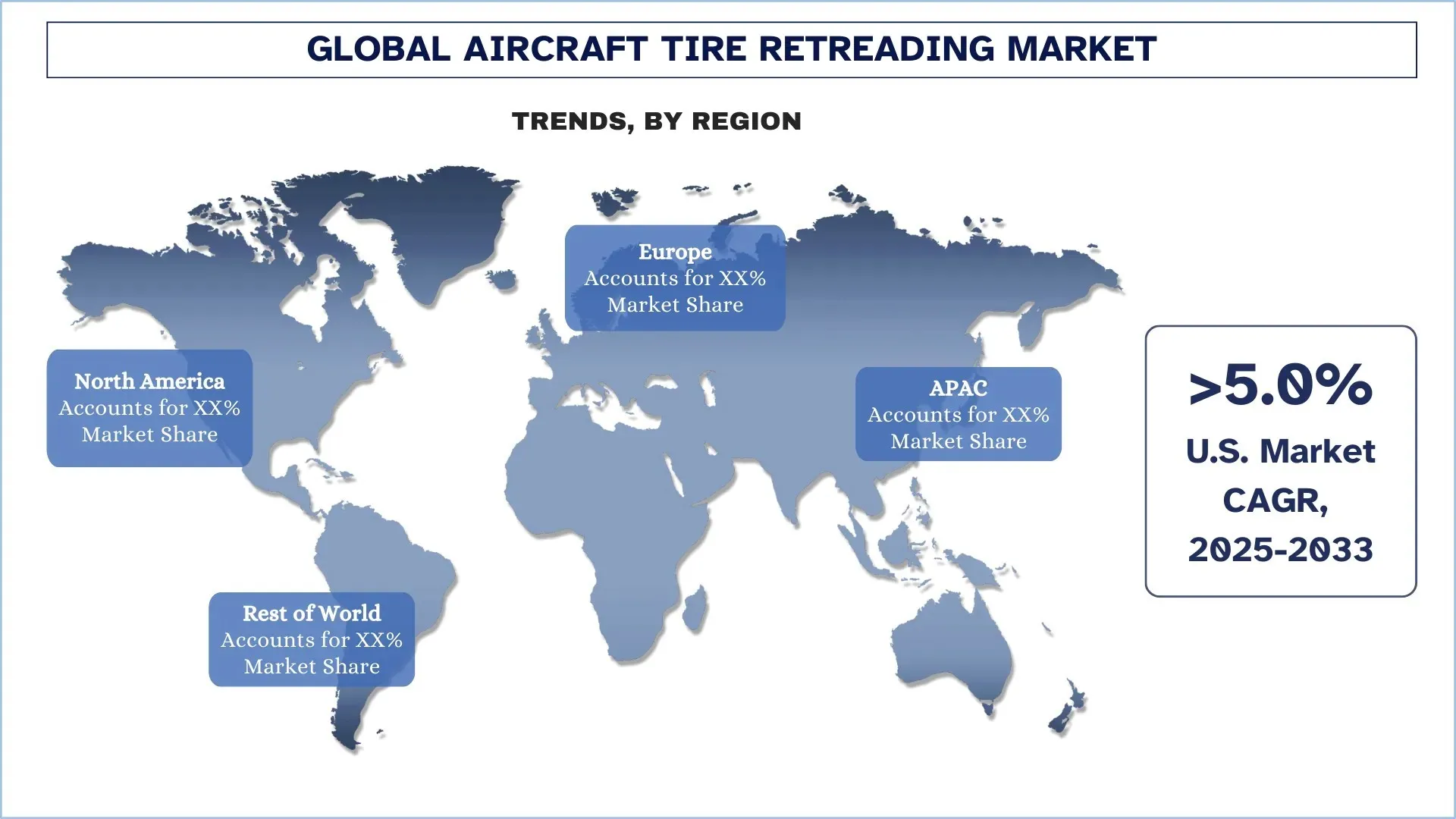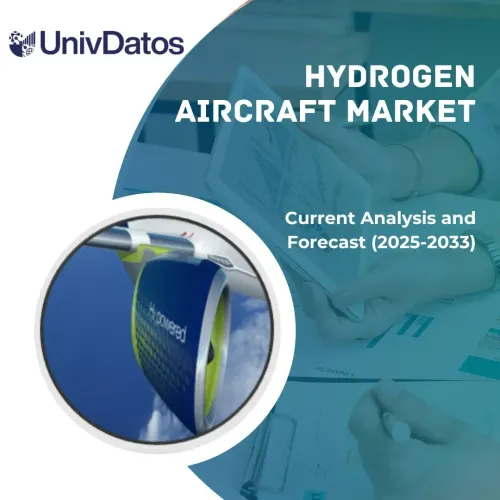- Home
- About Us
- Industry
- Services
- Reading
- Contact Us
Aircraft Tire Retreading Market: Current Analysis and Forecast (2025-2033)
Emphasis on Process Type (Pre-cure and Mold-cure); Aircraft Type (Commercial and Military); and Region/Country

Global Aircraft Tire Retreading Market Size & Forecast
The Global Aircraft Tire Retreading Market was valued at USD 3,394.37 million in 2024 and is expected to grow at a CAGR of around 4.31% during the forecast period (2025-2033F), driven by the rapid expansion of global air traffic, rising fleet modernization initiatives, and the growing emphasis on cost-effective and sustainable maintenance practices.
Aircraft Tire Retreading Market Analysis
Increasing volumes of air traffic, combined with more stringent safety, sustainability, and cost-efficiency requirements, have fueled the growth of the global aircraft tire retreading market in the aviation maintenance sector. Retreading systems are meant to prolong the life of the tires by re-treading worn tires, maintaining the integrity of the casing, and varying stress loads through tailored inspection, buffing, building, curing, and quality control that will enable worn aircraft tires to become safe, certified, and reliable properties. Unlike the conventional tire replacement cycles, aircraft tire retreading is constructed to be modular, cost-effective, automated, and possessing advanced NDT technologies capable of operating under extreme takeoff and landing conditions, as well as supporting operations in the fleet and low total operating costs. Circular economy, minimized carbon footprints, and optimized supply chains that airlines and MRO providers seek to achieve through cost stability, minimized use of raw materials, and improvement of ESG performance, enhance expansion. Also, the acceleration of retreading programs, waste-to-landfill, and carbon emissions reduction in aviation treaties is being motivated by policy frameworks, OEM approvals, and airport sustainability standards, and this is aligned with the corporate net-zero pledges. Applications are on the rise, with retread tires servicing commercial airlines, cargo fleets, military operations, and regional carriers. Developers are testing new high-performance rubber compounds, automated retreading, and RFID tagging, and the industry is well-positioned to implement reliable, cost-effective, and environmentally responsible tire management in global aviation.

Global Aircraft Tire Retreading Market Trends
This section discusses the key market trends that are influencing the various segments of the global aircraft tire retreading market, as found by our team of research experts.
Advanced Automation Inspection and Digitalization
One of the trends in the global aircraft tire retreading market is the increasing adoption of advanced automation and inspection technologies, as well as the digitalization of the retreading value chain. With increasing demands for aviation safety, operational efficiency, and optimization of fixed and variable costs, manual inspection and traditional retreading practices have proven to be ineffective in keeping pace with the increasing demands of the industry. Digital methods, which are conventional in examining tire casings, have been found to be too restricted in detecting micro-defects, structural weakness, or consistencies within the tire casing. The automation of the inspection line and retreading through robots helps to achieve uniformity, minimizes human error, and decreases downtime, thus ensuring compliance with federally mandated safety regulations. Additionally, IoT-based digital platforms provide real-time monitoring, predictive maintenance practices, and data-driven decision-making. These innovations have not only optimized resource usage and reduced operational costs; they have also enhanced sustainability initiatives by prolonging the lifecycle and reducing waste in tire manufacturing. Advanced automation and digitalization then become cornerstones fame to safety, reliability, and sustainability in the aircraft tire retreading market.
Aircraft Tire Retreading Industry Segmentation
This section provides an analysis of the key trends in each segment of the global aircraft tire retreading market report, along with forecasts at the global, regional, and country levels for 2025-2033.
The Pre-cure Segment Dominates the Aircraft Tire Retreading Market
Based on process type, the aircraft tire retreading market is segmented into pre-cure and mold-cure. In 2024, the pre-cure segment dominated the market and is expected to maintain leadership throughout the forecast period. This is primarily because it is cost-effective, it can operate flexibly, and can also increase its casing life through numerous retread cycles, which is of significance, more so to the commercial airlines that have large fleets. Operators prefer pre-cure retreading because it is relatively less capital-intensive, fast and efficient in tread application, and can provide consistent performance without breaching the strict aviation standards. Another important aspect that leads to pre-cure leadership is its scalability, whereby other tread patterns and compounds can be used under different circumstances and in various aircraft. Furthermore, the process allows proper utilization of casing and reduces quality checking to make it safer and reliable during high-stress landing and take-off processes. With these design efficiencies, airlines and MROs have the opportunity to reduce their operating costs, particularly in relation to tires, reduce wastage, and improve turnaround times, which will enhance the application of pre-cure retreading in the aviation industry.
The Commercial Aircraft Category held the Largest Market Share in the Aircraft Tire Retreading Market
Based on aircraft type, the aircraft tire retreading market is segmented into commercial and military. In 2024, the commercial segment dominated the market and is expected to maintain leadership throughout the forecast period. This is primarily because of the large number of passenger and cargo airplanes that are in the air all over the world, the frequency of the takeoff and landing processes, and the cost pressures that are put on airlines to maximize maintenance spending. The commercial segment of a used tire is preferred by operators due to its proven quality, safety certification, and original performance. It allows more retreads to be used without loss in casing strength, and also satisfies the requirements of aviation authorities. The other significant factors that facilitate commercial leadership are the increased implementation of retread programs by major carriers and leasing companies to fulfill sustainability goals, minimize landfill waste, and decrease carbon footprints. Moreover, the emergence of new fleet operations, the emerging markets in particular, and the increase in the number of low-cost airlines only increase the demand for cost-efficient tire management solutions. These drivers in the market ensure that retreaded tires in the commercial market are a critical facilitator of the safe, reliable, and financially viable operations of the entire global aviation industry.
North America Dominated the Global Aircraft Tire Retreading Market
North America is the largest market in the aircraft tire retreading industry and is likely to remain the market leader throughout the forecast period. The reason behind this leadership largely lies in the vast nature of the commercial aviation industry in the area, particularly in the United States, which has some of the largest airline fleets and maintenance, repair, and overhaul (MRO) services providers in the world. The excessive number of flight movements at major hubs has significantly increased the pressure to use retreaded tires. North America also has large manufacturers of retreading technologies and specialty aviation services companies, which provide advanced, certified retread solutions to both commercial and military aircraft worldwide. The region possesses a healthy aerospace industry, which is highly concentrated on cost optimization and sustainability of maintenance, thereby making it a large market for tire retreading. The market is also driven by stringent FAA and military requirements, as well as increased ESG obligations, which have prompted airlines and defense operators to adopt retread programs over total tire replacement to minimize waste and ensure dependable and economical fleet maintenance. In August 2024, Dunlop Aircraft Tyres Inc. was awarded a U.S. Department of Defense contract valued at approximately USD 7.64 million to supply aircraft tires for U.S. military fleets. The contract highlights the ongoing relevance of North America (particularly the U.S.) as one of the key markets and shows how defense operators are aggressively acquiring retreaded tire services on long-term contracts.
U.S. held a dominant Share of the North America Aircraft Tire Retreading Market in 2024
The US Aircraft tire retreading market is characterized by high potential and growth potential due to the consistent increase in air traffic, growth of commercial and regional fleets, and the growing concern about cost optimization in the entire aviation maintenance industry. The new technologies included in the market, which include laser shearography, non-destructive testing (NDT), RFID tagging, and digital inspection platforms, are also benefiting the market by assuring the safety of its tires, enhancing service life, and lowering the total costs of maintenance. Moreover, the increasing focus on environmentally friendly and sustainable solutions is driving the transition to the solutions of the circular economy, as retreading results in a substantial decrease in the consumption of raw materials and carbon emissions in comparison with new tire manufacturing.

Aircraft Tire Retreading Industry Overview
The global Aircraft Tire Retreading market is competitive, with several global and international market players. The key players are adopting different growth strategies to enhance their market presence, such as partnerships, agreements, collaborations, new product launches, geographical expansions, and mergers and acquisitions.
Top Aircraft Tire Retreading Companies
Some of the major players in the market are Bridgestone Corporation, The Goodyear Tire & Rubber Company, Dunlop Aircraft Tyres Limited, VSE Aviation, MICHELIN, and Skytreads.
Recent Developments in the Aircraft Tire Retreading Market
In 2024, Bridgestone Corporation unveiled a new lunar rover tire with enhanced performance following extensive research and development efforts. The innovative concept model was debuted at the 39th Space Symposium, the largest space-related event in the United States, in Colorado Springs. Bridgestone's exhibit will be part of Japan's Space Industry booth, hosted by the Japan Aerospace Exploration Agency (JAXA).
In August 2024, Dunlop Aircraft Tyres Inc. was awarded a U.S. Department of Defense contract valued at approximately USD 7.64 million to supply aircraft tires for U.S. military fleets. The contract highlights the ongoing relevance of North America (particularly the U.S.) as one of the key markets and shows how defense operators are aggressively acquiring retreaded tire services on long-term contracts.
Global Aircraft Tire Retreading Market Report Coverage
Details | |
Base year | 2024 |
Forecast period | 2025-2033 |
Growth momentum | Accelerate at a CAGR of 4.31% |
Market size 2024 | USD 3,394.37 Million |
Regional analysis | North America, Europe, APAC, Rest of the World |
Major contributing region | North America is expected to dominate the market during the forecast period. |
Key countries covered | U.S., Canada, Germany, U.K., Spain, Italy, France, China, Japan, and India |
Companies profiled | Bridgestone Corporation, The Goodyear Tire & Rubber Company, Dunlop Aircraft Tyres Limited, VSE Aviation, MICHELIN, and Skytreads |
Report Scope | Market Trends, Drivers, and Restraints; Revenue Estimation and Forecast; Segmentation Analysis; Demand and Supply Side Analysis; Competitive Landscape; Company Profiling |
Segments Covered | By Process Type; By Aircraft Type; By Region/Country |
Reasons to Buy the Aircraft Tire Retreading Market Report:
The study includes market sizing and forecasting analysis confirmed by authenticated key industry experts.
The report briefly reviews overall industry performance at a glance.
The report covers an in-depth analysis of prominent industry peers, primarily focusing on key business financials, type portfolios, expansion strategies, and recent developments.
Detailed examination of drivers, restraints, key trends, and opportunities prevailing in the industry.
The study comprehensively covers the market across different segments.
Deep dive regional-level analysis of the industry.
Customization Options:
The global Aircraft Tire Retreading market can further be customized as per the requirements or any other market segment. Besides this, UnivDatos understands that you may have your own business needs; hence, feel free to contact us to get a report that completely suits your requirements.
Table of Content
Research Methodology for the Global Aircraft Tire Retreading Market Analysis (2023-2033)
We analyzed the historical market, estimated the current market, and forecasted the future market of the global aircraft tire retreading market to assess its application in major regions worldwide. We conducted exhaustive secondary research to gather historical market data and estimate the current market size. To validate these insights, we carefully reviewed numerous findings and assumptions. Additionally, we conducted in-depth primary interviews with industry experts across the aircraft tire retreading value chain. After validating market figures through these interviews, we used both top-down and bottom-up approaches to forecast the overall market size. We then employed market breakdown and data triangulation methods to estimate and analyze the market size of industry segments and sub-segments.
Market Engineering
We employed the data triangulation technique to finalize the overall market estimation and derive precise statistical numbers for each segment and sub-segment of the global aircraft tire retreading market. We split the data into several segments and sub-segments by analyzing various parameters and trends, including process type, aircraft type, and regions within the global aircraft tire retreading market.
The Main Objective of the Global Aircraft Tire Retreading Market Study
The study identifies current and future trends in the global aircraft tire retreading market, providing strategic insights for investors. It highlights regional market attractiveness, enabling industry participants to tap into untapped markets and gain a first-mover advantage. Other quantitative goals of the studies include:
Market Size Analysis: Assess the current market size and forecast the market size of the global aircraft tire retreading market and its segments in terms of value (USD).
Aircraft Tire Retreading Market Segmentation: Segments in the study include areas of process type, aircraft type, and regions.
Regulatory Framework & Value Chain Analysis: Examine the regulatory framework, value chain, customer behavior, and competitive landscape of the aircraft tire retreading industry.
Regional Analysis: Conduct a detailed regional analysis for key areas such as Asia Pacific, Europe, North America, and the Rest of the World.
Company Profiles & Growth Strategies: Company profiles of the aircraft tire retreading market and the growth strategies adopted by the market players to sustain the fast-growing market.
Frequently Asked Questions FAQs
Q1: What is the global Aircraft Tire Retreading Market's current market size and its growth potential?
The global aircraft tire retreading Market was valued at USD 3,394.37 million in 2024 and is expected to grow at a CAGR of 4.31% during the forecast period (2025-2033).
Q2: Which segment has the largest share of the global Aircraft Tire Retreading Market by Process Type?
The pre-cure segment dominated the market and is expected to maintain leadership throughout the forecast period. This is primarily because it is cost-effective, can operate flexibly, and can also increase its casing life through numerous retread cycles, which is particularly significant for commercial airlines with large fleets.
Q3: What are the driving factors for the growth of the global Aircraft Tire Retreading Market?
• Growth in Global Air Traffic and Fleet Expansion: Rising passenger demand and increased flight frequency put higher stress on aircraft tires, boosting the need for retreading as a cost-effective and reliable maintenance solution.
• Cost Efficiency and Operational Savings: Retreading extends tire life cycles, significantly lowers maintenance costs, and minimizes the need for new tire production, providing airlines and MROs with predictable cost savings and operational efficiency.
• Sustainability and Circular Economy Initiatives: By reducing raw material use, lowering carbon emissions, and cutting waste, tire retreading supports airlines’ ESG targets, net-zero commitments, and circular economy practices in aviation operations.
Q4: What are the emerging technologies and trends in the global Aircraft Tire Retreading Market?
• Advanced Automation Inspection and Digitalization: AI-driven inspection, IoT platforms, and robotics in retreading improve accuracy, reduce human error, and enable predictive maintenance, ensuring safety compliance while lowering costs and turnaround times.
• Shift Toward Mold-Cure or Hybrid Retreading Processes: Adoption of mold-cure and hybrid processes provides enhanced tire durability, better performance consistency, and extended service life, aligning with operators’ demand for reliability and cost-effectiveness.
Q5: What are the key challenges in the global Aircraft Tire Retreading Market?
• Stringent Regulatory and Certification Standards: Aircraft tire retreading must comply with strict FAA, EASA, and OEM standards, requiring rigorous testing and certification that can increase costs and slow market adoption.
• Perception and Trust Issues: Some operators still view retreaded tires as less reliable than new ones, creating trust barriers despite proven safety records and advancements in retreading technology and inspection systems.
Q6: Which region dominates the global Aircraft Tire Retreading Market?
North America leads the aircraft tire retreading market and is set to maintain dominance, driven by high air traffic, large commercial and military fleets, and strong adoption of advanced retreading technologies and sustainability initiatives.
Q7: Who are the key players in the global Aircraft Tire Retreading Market?
Some of the key players include:
• Bridgestone Corporation
• The Goodyear Tire & Rubber Company
• Dunlop Aircraft Tyres Limited
• VSE Aviation
• MICHELIN
• Skytreads
• Others
Q8: What is the current regulatory landscape for the Aircraft Tire Retreading market, and how does it impact operators?
• Aviation Safety Compliance: FAA, EASA, and ICAO mandates ensure strict inspection, testing, and certification for retreaded tires.
• OEM Approvals: Aircraft manufacturers’ endorsements are critical for airline adoption.
• Standardization: Global harmonization of retreading practices helps maintain quality, boosting trust and operational safety.
Q9: How do technological advances shape investment opportunities in the Aircraft Tire Retreading market?
• Automated Inspection Systems: AI-driven NDT and laser shearography attract investment by improving accuracy and safety.
• Digital Platforms: IoT and predictive analytics enable data-driven maintenance, appealing to investors.
• Material Innovation: New rubber compounds and mold-cure processes extend tire life, offering profitable returns.
Related Reports
Customers who bought this item also bought










